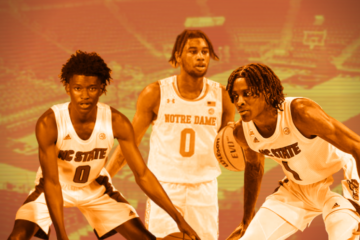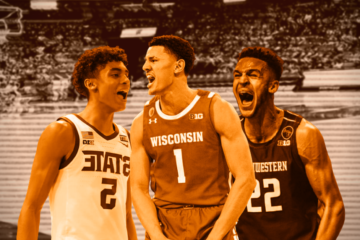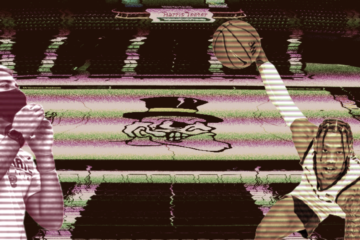While it’s been a chaotic holiday season in the basketball world in the midst of the Omicron variant spreading like wildfire, I was fortunate to make my way to scout Notre Dame at Pitt and take in a competitive game unscathed by COVID absences or postponement.
As a Notre Dame alumnus who grew up outside of Pittsburgh, it was a true pleasure to have the opportunity to scout this game in my hometown while in town visiting family for the holidays.
While there’s only one prospect on either team drumming up notable NBA buzz, this turned out to be a very worthwhile scouting endeavor. Let’s dive into the takeaways on a handful of prospects of varying levels.
Blake Wesley | Notre Dame
Fr. | Combo Guard | 6’5” | 185 lbs. | 3/16/2003
12 PTS, 0 OREB, 0 DREB, 3 AST, 0 STL, 0 BLK, 3 TOV, 4 PF, 53.0 TS%
There were five NBA scouts in attendance, all of which were keyed in on Wesley. He’s caught the attention of front offices around the NBA, so I’d anticipate teams’ scouting calendars to be adjusted to make some pit stops in South Bend throughout conference play.
I arrived early to watch Wesley warm up and get a close-up look at his shot mechanics.
Getting my first live look at Notre Dame freshman, Blake Wesley.
— Jon Chepkevich (@JonChep) December 29, 2021
The South Bend native is a sharp-rising 2022 NBA Draft prospect.
Gaining significant momentum toward becoming the program’s first ever one-and-done. pic.twitter.com/iwZzofyuLY
As can be seen in the slow-mo video above, Wesley seems to be a left eye dominant shooter. This isn’t necessarily inherently bad, but without proper mechanical tweaks and adjustments can cause some shooting sporadicity (i.e. early Lonzo Ball). Wesley is a right-handed shooter who brings the ball up slightly favored toward the left side of his face, but ultimately has a clean, high release that makes its way back to the midline.
All-in-all, this may be a contributing factor to some of Wesley’s streakiness as a shooter and sub-70 FT%, but isn’t a major concern and seems like something that can be tidied up.
This streakiness extended to Blakes’s overall performance against the Panthers. He had some sloppy turnovers, all of which occurred within the first couple of minutes of each half.
He also picked up his second foul well before the first television timeout.
While these kinds of early, aggressive mistakes aren’t uncommon for young, blossoming stars, Wesley will need to learn to hone this in and play with a more controlled pace in the early going.
When things were good for Wesley, they were REALLY good.
He ripped off eight points in a minute and a half, scoring on three consecutive possessions.
Here’s another angle of the drive:
Blake Wesley showing his burst, blowing by the defender for the easy bucket.
— Jon Chepkevich (@JonChep) December 29, 2021
Eight consecutive points, knocked down two deep threes the prior two possessions. pic.twitter.com/oxoo6enLpm
While his 2.1% stock (STL + BLK) rate doesn’t jump off the page, Wesley’s defensive engagement and positioning have been quite impressive throughout the season. This continued to be the case against Pitt, peaking during this 2 minute stretch in the middle of the second half:
Wesley shows great help instincts at the nail, is well-positioned as a helpside defender, moves his feet as an on-ball defender, and makes things difficult for Hugley with a timely, effective dig. While none of this shows up in his stat line, Wesley forced two turnovers and played textbook defense throughout the duration of these possessions.
Down the stretch, Wesley got into the teeth of the defense, drew help, and kicked to open three-point shooters on critical back-to-back possessions.
When he’s assertive in getting downhill as a slasher as opposed to settling for pull-ups, Wesley is really hard to contain and puts a ton of pressure on opposing defenses both as a rim-finisher and facilitator for others.
Bottom Line: Wesley looks to be a RD1 talent. While there are some ups and downs, this is to be expected given his role and age. Wesley bears an unusually heavy creation load for someone his age (the only high-major freshman in the nation with a 30.0+ USG%). The consistency seems likely to come along in due time. If he grows more comfortable in his decision-making as the conference play progresses, Wesley has a very real chance of being selected in the first round of the 2022 NBA Draft.
If he opts to return for his sophomore campaign, Wesley could be poised for a trajectory not all that dissimilar to that of fellow South Bend native, Jaden Ivey.
Nate Laszewski | Notre Dame
Sr. | Forward | 6’10” | 235 lbs. | 7/19/1999
5 PTS, 2 OREB, 4 DREB, 0 AST, 0 STL, 0 BLK, 1 TOV, 4 PF, 125.0 TS%
Laszewski wasn’t overly assertive in this game and Pitt clearly knew it was in their best interest to run him off the line. He took only two shots, converting both, and was otherwise quiet offensively.
He was, however, quietly effective on the defensive end. While he didn’t notch any blocks or steals in the stat sheet, Laszewski did a really nice job of battling on the interior, maintaining verticality, forcing catches outside of the paint, and hitting the glass.
While John Hugley (an absolute unit) had a strong offensive showing and bullied Laszweski a couple of times, Laszewski made it tough on him when called upon. Hugley did most of his damage against Paul Atkinson and at the free throw line.
Bottom Line: Laszewki had some light late RD2 draft buzz this offseason, but hasn’t quite lived up to that billing. He has regressed a bit as a paint finisher and has only gotten to the free throw line for three total attempts on the season. While this is certainly disappointing, there are only so many 6’10” prospects with his level of shooting prowess, so that will always drive some interest.
It remains to be seen whether Laszewski opts to take advantage of his extra year of eligibility, but whether he goes pro this year or next, he should warrant consideration for PIT and Tampa Bay Pro Combine invitations. Having lived in both Belgium and Australia throughout his childhood, don’t be surprised to see Laszewski end up in the BNXT League early in his career and potentially the Australian NBL down the line.
Dane Goodwin | Notre Dame
Sr. | Wing | 6’6” | 208 lbs. | 12/28/1999
11 PTS, 0 OREB, 6 DREB, 4 AST, 0 STL, 0 BLK, 1 TOV, 3 PF, 68.8 TS%
Goodwin has been one of the steadiest, most consistent players in the ACC in the early season. Fresh off of receiving ACC Player of the Week honors the week prior, Goodwin had yet another quietly productive, highly efficient outing.
About one third of Goodwin’s offensive possessions are spot-ups, wherein he ranks in the 99th percentile by converting at a ~1.56 point-per-possession clip. He kept that humming against Pitt, knocking down three of his four attempts from deep, all of which were of the spot-up variety.
Goodwin has been a consistently strong rebounder throughout his career and that shined through in this match-up. While not particularly long or explosive, Goodwin has a sturdy frame and is quick enough off his feet from a two-foot standstill to make a notable impact on the glass.
What Goodwin typically lacks offensively is effectiveness in leveraging his shooting gravity to create advantages, knife into the paint, and create opportunities for teammates. He is averaging less than one assist per game on the season, but actually showed a couple of encouraging flashes in drawing help in the paint and kicking to shooters in the corners.
Goodwin may not have the handle or self-creation package to bend defenses off the bounce in isolations or pick-and-rolls, but there is reason to believe he could make improvements as a drive-and-kick facilitation threat attacking off the catch.
Bottom Line: While Goodwin may not be a clean NBA translation, he has steadily improved year-over-year to the point that he should be quite appealing as a rookie import and will likely draw consideration for a strong entry level European landing spot with a chance to climb the European ladder sooner rather than later.
Mo Gueye | Pitt
The JUCO product and 2020-21 AEC Defensive Player of the Year transferred from Stony Brook to Pitt this offseason and, while he took a few weeks to find his footing, has been really impactful for the Panthers of late and is settling into his role.
Gueye brought consistent energy throughout the entirety of the game on both ends of the court.
While Gueye’s rim-protection prowess has been evident as the AEC’s leading shot-blocker each of the past two seasons at Stony Brook, his development as a floor-spacing stretch four really unlocks things for Pitt’s offense and makes him a perfect pairing with traditional post-up big man, John Hugley. Gueye is attempting more than 2.7 times as many threes per 100 possessions than last season and knocking down a higher percentage, to boot.
He looks quite confident as a shooter with reasonably good form and some positive statistical indicators (has increased FT% and 3P% each season).
Bottom Line: While Gueye is certainly on the older side and not on NBA Draft radars, he will have a wide array of appeal internationally with a desirable combination of length (7’3” wingspan), rim-protection, and three-point shooting. Mobile fours and fives with high motors who can both block shots and space the floor are few and far between.
Others Notables
I’d be remiss not to mention Notre Dame senior, Prentiss Hubb. While he’s had a rough start to the season (shooting only 33.3% from the field on a career low 7.8 PPG), Hubb has over 3,500 career minutes under his belt and Notre Dame still very much leans on his leadership and experience in critical moments. Hubb tied a season-high with 15 points, 13 of which came in the second half, including the game winner.
Tough game-winner by Notre Dame senior guard, Prentiss Hubb.
— Jon Chepkevich (@JonChep) December 29, 2021
Notre Dame - 68
Pitt - 67
First ACC win of the season for the Irish. pic.twitter.com/A3z2xJWhgy
John Hugley was also a clear stand-out for Pitt, finishing with 18 PTS, 6 REB, 3 AST, 3 STL.
He’s a powerful, wide-bodied 6’9” big man who busted up Notre Dame’s front line and lived at the free throw line, knocking down all eight attempts. His sophomore breakout has been impressive and his low-post physicality is difficult to stop, but it remains to be seen if he can round out the ancillary aspects of his game to break beyond the “old school” big ceiling. He’ll need to improve his body, become a more viable rim-protector, and expand his perimeter game to up his translatability to the professional level.


